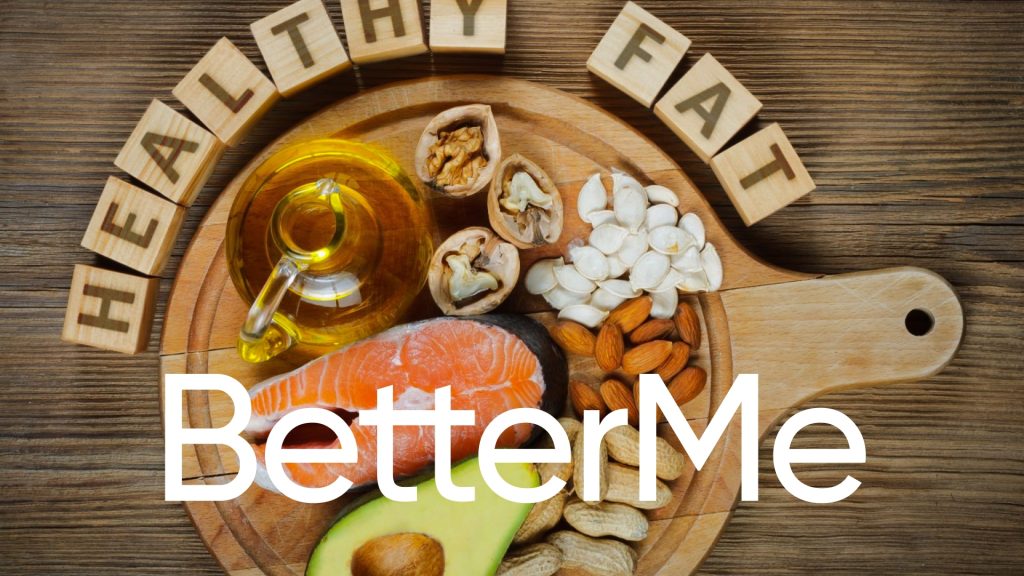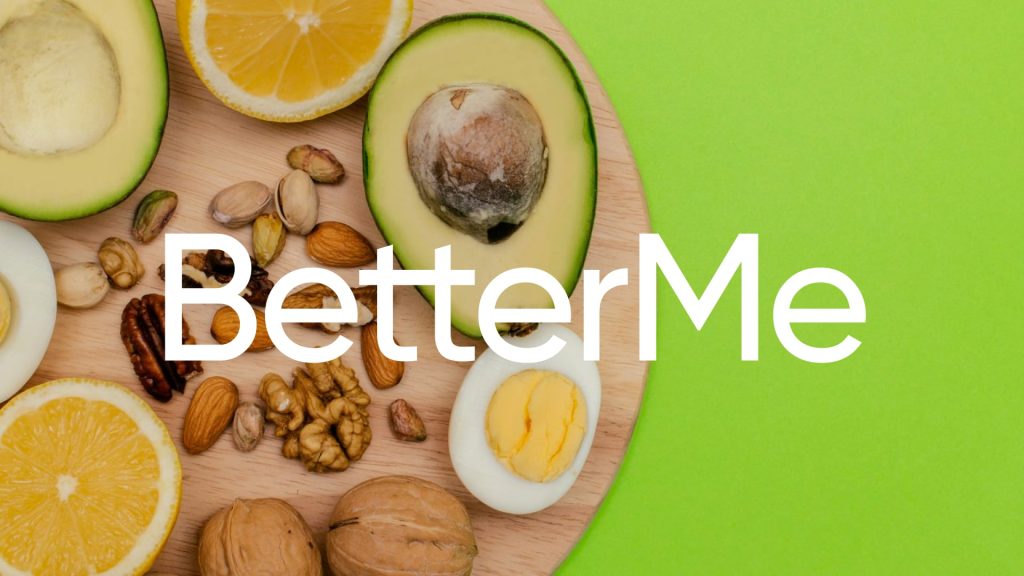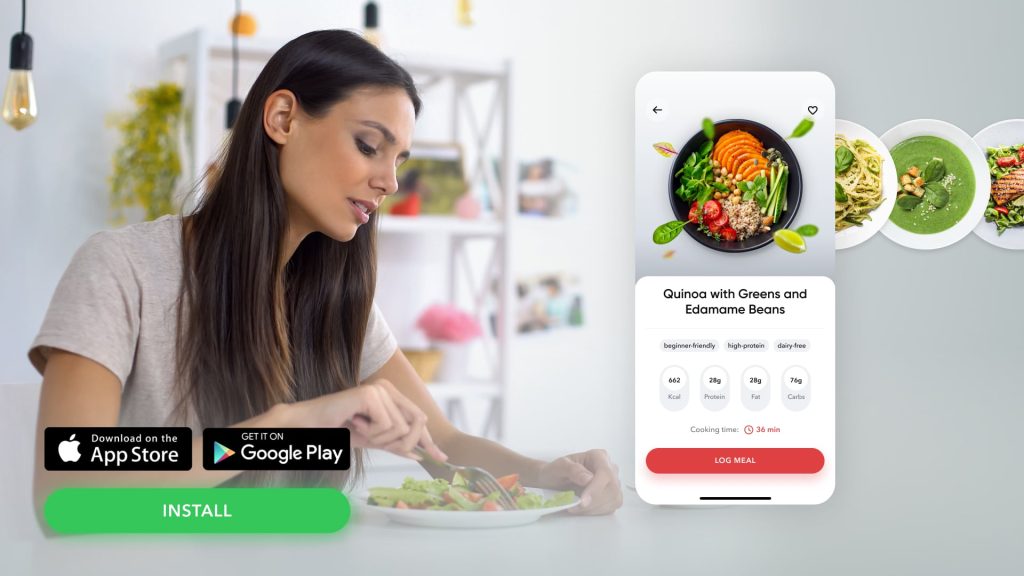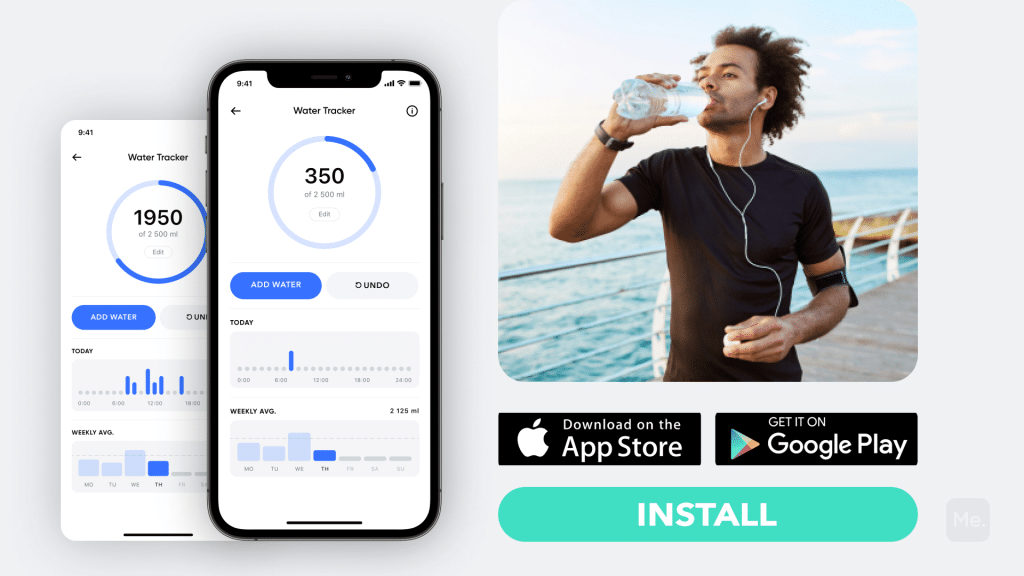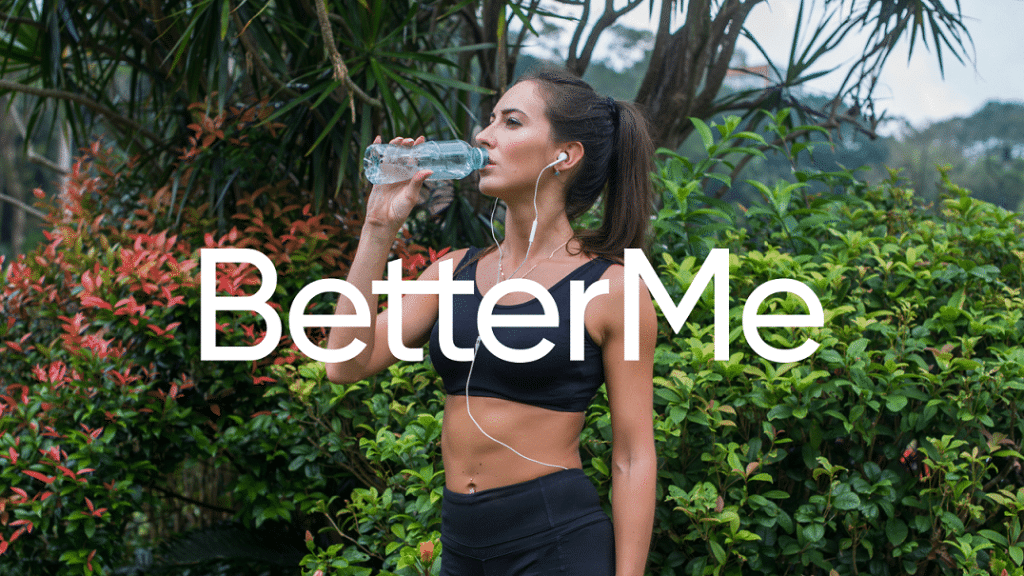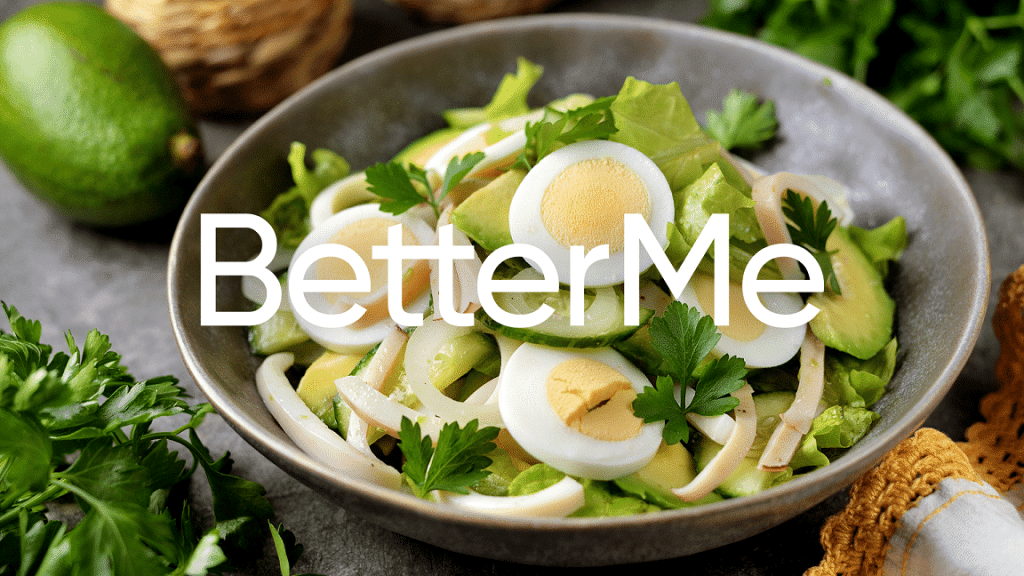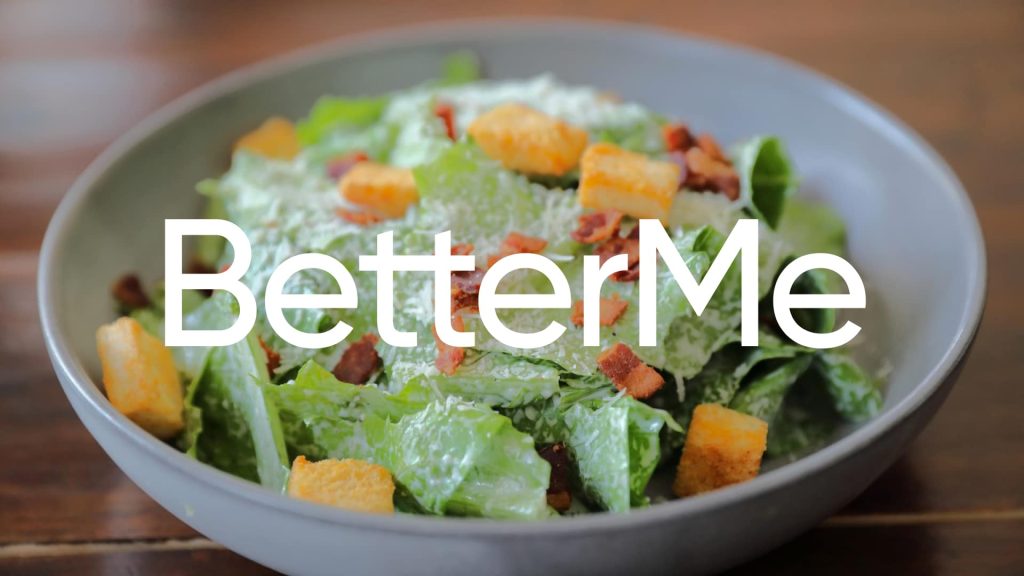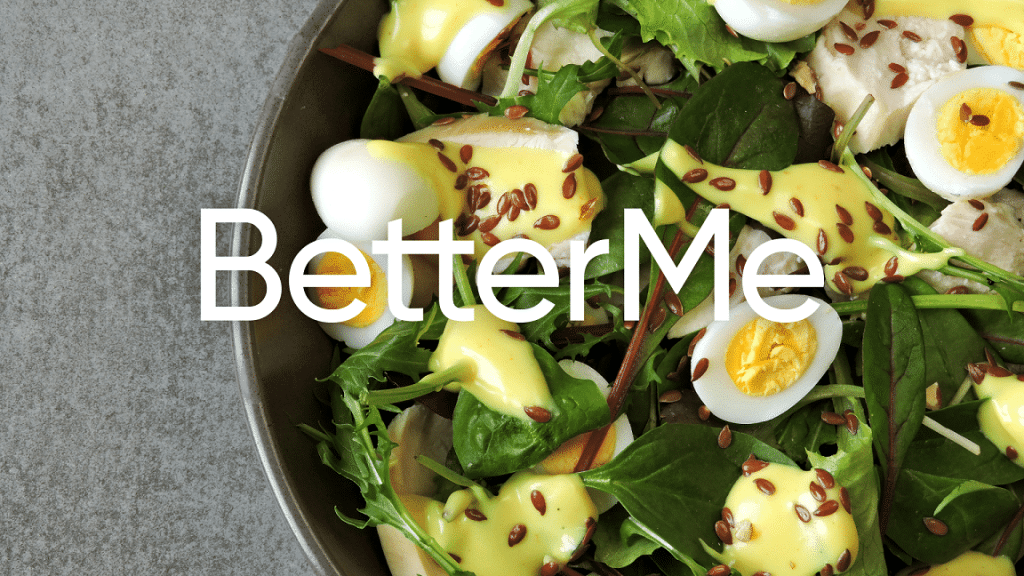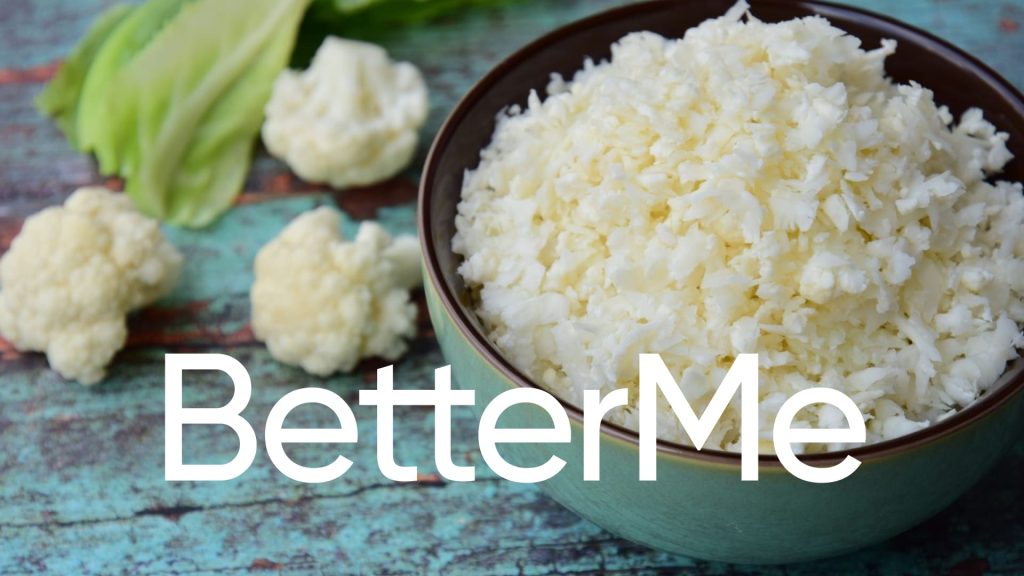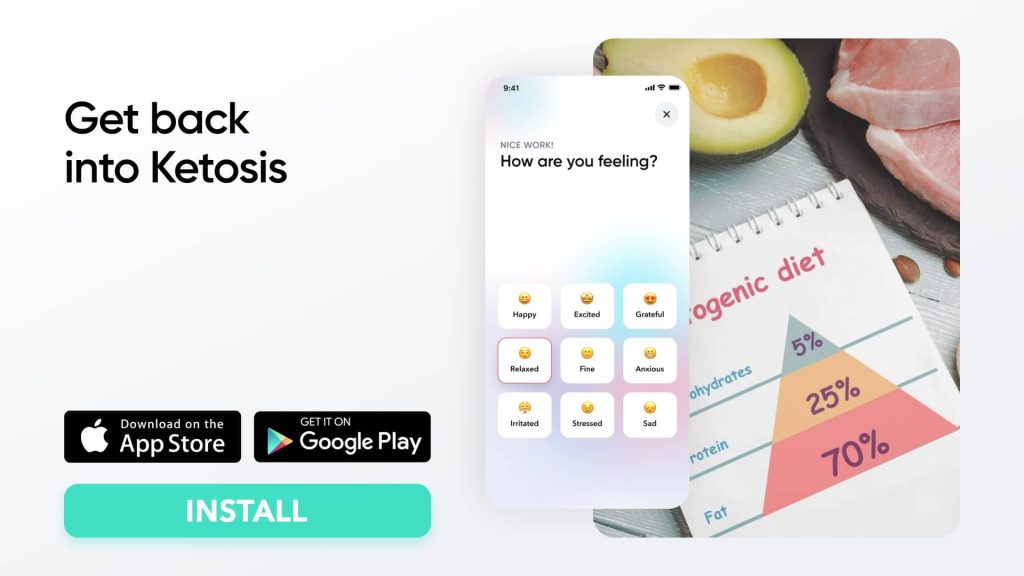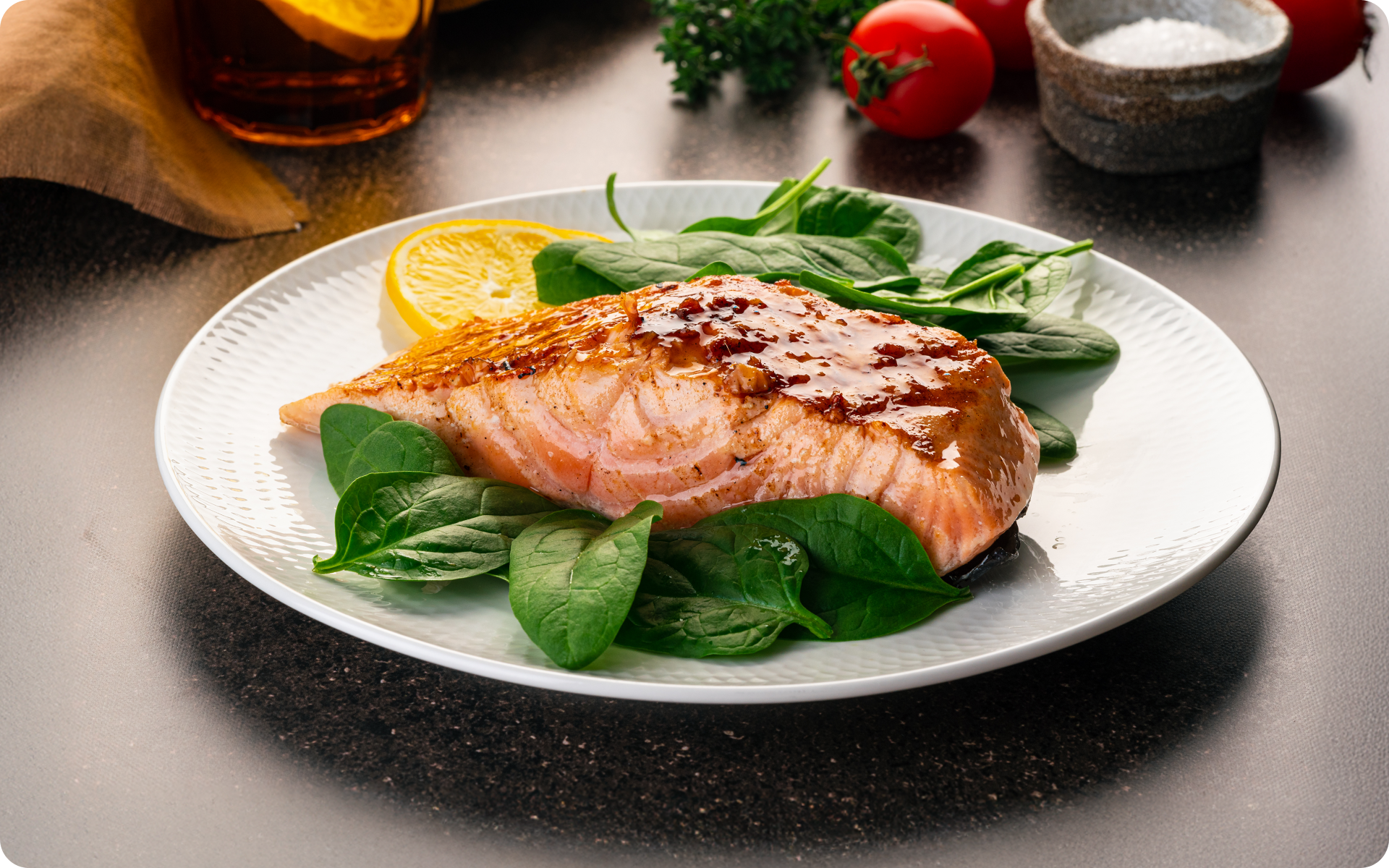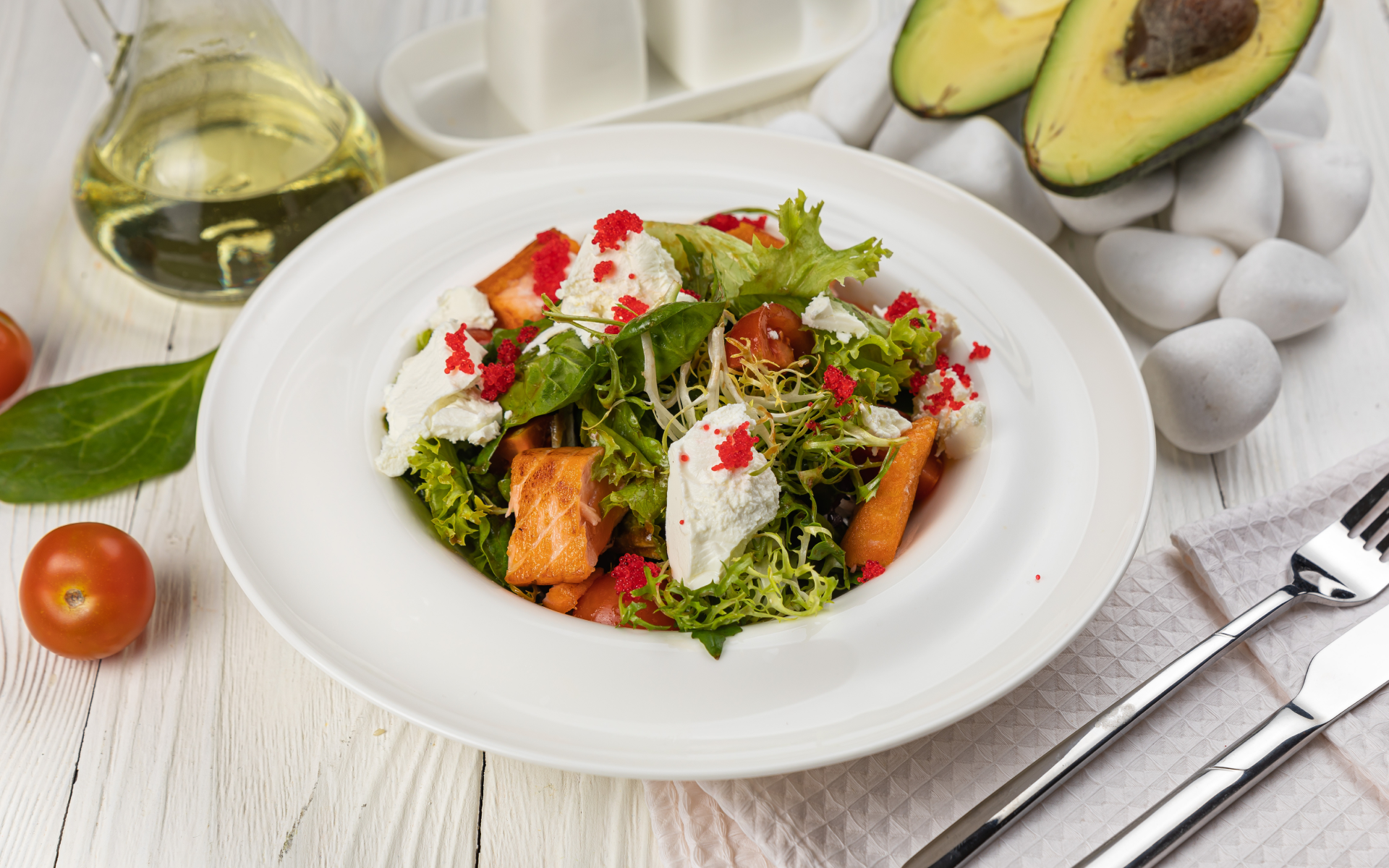The Keto Calculator: How To Calculate Your Macros For Keto
Macronutrients or macros provide your body with calories and energy. They are broken down into three main categories: Carbohydrates, Proteins, and Fats. It is important to track your macronutrients while following the ketogenic diet because the goal is to limit your carbohydrate intake so that your body utilizes fat as the primary source of energy. A keto diet is high in fats, moderate in protein, and low in carbs (21). Do you know how the keto calculator counts your daily macros? Let’s break it down into simple steps.
Get your personalized
meal plan!
Step 1: Gather Your Details: Gender, Age, Height, And Weight
The keto calculator takes into account your gender, age, height, and weight to determine your basal metabolic rate (BMR), which is the minimum number of calories needed for your body to properly function while resting.
BMR is calculated through Mifflin-St.Jeor Formula as it is the most precise method (9).
- Men: calories/day = 10 x weight (kg) + 6.25 x height (cm) – 5 x age (y) + 5
- Women: calories/day = 10 x weight (kg) + 6.25 x height (cm) – 5 x age (y) – 161
For instance, If a 35 year old man weighs 90kg and his height is 175 cm. His BMR would be:
BMR = 10 x 90kg + 6.25 x 175cm – 5 x 35years +5 = 1823.75 ≈ 1824 calories/day
= 900 + 1093.75 – 175 +5 = 1823.75 ≈ 1824 calories/day
Why are these details necessary?
- Gender: Men and Women have different body composition.
- Age: Resting metabolic rate (the number of calories burned at rest) decreases with age.
- Height and Weight: Unique body composition always needs to be taken into account.
Read More: 30 Day Keto Challenge: Will Upping Your Fat Intake Help You Lose Weight?
Step 2: Figure Out Your Calorie Intake Goal
To calculate your macros for keto, you need to establish your Total Daily Energy Expenditure (TDEE), which is the estimate of energy or calories you burn a day through physical activities and rest.
The basal metabolic rate you calculated from Step1 is necessary to determine your TDEE. This is done by multiplying your BMR with an activity factor.
- Sedentary: limited to no exercise with a desk job _ BMR x 1.2
- Lightly active: light exercise one to three times per week _ BMR x 1.375
- Moderately active: moderate exercise three to five times per week _ BMR x 1.55
- Very active: hard exercise six to seven times per week _ BMR x 1.725
- Extra active: arduous exercise daily and a physical job _ BMR x 1.9
If the same 35 year-old-man leads a sedentary lifestyle, his TDEE would be:
TDEE = BMR x 1.2
1824 kcal x 1.2 = 2188.5 Calories/Day
Next, you need to determine your end goal, which is losing weight, gaining weight, or maintaining weight. When you know how many calories you need to consume each day, you can then break it down to the corresponding amount of macros you need.
Step 3: Determining Body Fat % And Lean Body Mass
Body fat % is the total amount of fat in the body. One of the most accurate methods to calculate Body fat % and Lean body mass is DXA (DEXA) Scan Body Composition testing . The only drawback is its cost. If that’s an issue, you can use the standard American Council on Exercise Body Fat Categorization
| Description | Women | Men |
| Essential fat | 10-13% | 2-5% |
| Athletes | 14-20% | 6-13% |
| Fitness | 21-24% | 14-17% |
| Average | 25-31% | 18-25% |
| Obese | 32+% | 25+% |
To determine your body fat percentage, you can use several tools like a body fat scale or calipers for skinfold measurement test. Once you know your body fat %, you can easily calculate your lean body mass, which is the remaining percentage that isn’t body fat. Keep in mind that lean body mass also includes muscle mass, bones and body fluid. Let’s take a look at this example:
If the weight is 200 pounds (90.9 Kg) and the body fat percentage is 25%, then the lean body mass is 75%, which in pounds would be:
- Body fat % = 25%*200 lbs = 50 lbs (22.73kg)
- Lean body mass = 200 lbs – 50 lbs = 150 lbs (68.18 kg)
Regarding your protein intake, research suggests to calculate your daily intake by using your lean mass instead of your current body weight. As an indicator, you should consume 0.7 to 1 grams per pound of lean body mass (1.6 to 2.2 grams per kg) for optimal muscle maintenance (17).
If the lean body mass is 100 lb, you would ideally need 70-100 grams of proteins to control your weight without losing your muscle mass.
The Keto Calculator: How Many Carbs To Eat On Keto
The keto diet is an ultimate low-carb diet, so your carb intake should be between 5-10% of your total calorie intake. Most ketogenic guidelines suggest staying under 50g net carbs a day. However, some people can only achieve their goal by restricting their net carbs intake to 20g per day, it really depends on each individual. Remember that the human body can’t digest and absorb fibers. Net carbs is an unofficial term that isn’t recognized by nutrition experts. It usually means “digestible and absorbable carbs”, which means simple and complex carbs.
Keeping your carbohydrate intake exceedingly low (between 20 to 50 grams per day) can be hard to achieve or maintain, and could increase the risks of limiting important nutrients, phytochemicals, and fiber in your diet. Therefore, it is preferable to avoid extreme restrictions if you can achieve a state of ketosis with a slightly increased carbohydrate intake.
The Ideal Plan
The ideal plan is to start with 50g per day and wait 2-4 days before getting tested (see the section below on How to know if you’re in ketosis?) to see if you have entered ketosis. If it is not the case, it is then recommended to progressively decrease your daily carbohydrate intake and repeat the process until you reach the minimal amount of 20 grams per day. It is not recommended to go below 20 grams of carbohydrates per day. Make sure to always check if you are in ketosis before decreasing your carbohydrate intake to avoid restricting your diet for no reason (8).
For example: In a person consuming 2000 calories a day.
2000 calories x 10% of carbs = 200 calories from carbohydrates
Since each gram of carbs = 4 calories
Therefore, 200/ 4 = 50 g of carbohydrates per day
Dropping pounds by the dozens without putting yourself through the wringer is everyone’s weight loss pipe dream. But what if we told you that the BetterMe app can make that happen? Keep yourself in prime shape with our fat-blasting workouts, delicious budget-sparing recipes, and body-transforming challenges with our app!
The Keto Calculator: How Much Protein To Eat On Keto
The amount of protein you eat is important on the keto diet. Too little protein and you start to lose muscle mass, too much protein, and you kick your body out of ketosis where your body will start to use protein as its energy source instead of fat. Most ketogenic guidelines suggest that your protein intake should be between 20-25% of your total daily energy intake (21). According to some experts, this should represent about 1.2-1.7g per kg of body weight.
For example: In a person (65 kg) consuming 2000 calories a day.
2000 calories x 20% of protein = 400 calories from protein per day.
Since each gram of protein = 4 calories
Therefore, 400/4 = 100 g of protein per day.
1.2 – 1.7g of protein per kg of body weight * 65 kg = 78 to 111 g of protein per day.
The Keto Calculator: How Much Fat To Eat On Keto
Since the keto diet is a high-fat diet, the rest of the calories you consume should come from fat, which should be between 70-80% of your total calorie intake.
For example: In a person consuming 2000 calories a day with 25 g of carbs and 100 g of protein.
25 g of carbs x 4 calories per gram = 100 calories
100 g of carbs x 4 calories per gram = 400 calories
Therefore, 2000 – 500 = 1500 calories of fat
Since every gram of fat = 9 calories
Therefore, 1500/9= 166.67 g of fat
2000 kcal * 0.7 = 1400 kcal
2000 kcal * 0.8 = 1600 kcal
In your example, energy intake from fat should be between 1400 and 1600 kcal per day.
The Keto Calculator: How Much Weight Can You Lose On Keto In A Week?
After the first week of keto, people experience rapid weight loss where they lose anywhere between a few pounds to as much as 10 pounds of their body weight. However, most of it is water weight. This is because glycogen (unused carbohydrates we store in our body) pulls in water, so when you switch to keto, your body will deplete its glycogen stores and get rid of the stored water at the same time (1).
History And Origin Of The Keto Diet
The keto diet was first introduced in 1921 by Russel Wilder to treat pediatric epilepsy. It was mainly introduced to mimic the effects of fasting, which helps decrease the frequency of seizures. It was widely used from the 1920s to the 1930s to help manage pediatric epilepsy; however, its use declined when new drugs were developed to treat the condition. There’s been a resurgence in popularity of the keto diet as an epilepsy treatment (7). However, the keto diet as a method for rapid weight loss is a fairly new concept.
How Does The Keto Diet Work?
On a regular diet, your body typically uses glucose (carbohydrates) as its main source of energy. However, the keto diet focuses on limiting the amount of carbohydrates you consume and increasing the amount of fat in your diet, thereby forcing your body to burn fat for energy. Due to the short supply of glucose, your liver converts dietary fats and stored body fats into ketones, which are used as fuel in the absence of glucose and puts you into a state of ketosis or fat-burning mode (11).
How To Know If You Are In Ketosis?
After starting the keto diet, it can take anywhere from a few days to a couple of weeks for your body to enter ketosis. Knowing if your body is in ketosis can help make sure you’re on the right track and following the keto diet correctly. The easiest way to test if you’re in ketosis is to find out the ketone levels in your body using a blood-testing meter. Reports claim most benefits appear once people reach 1.5 mmol/L. You can also use a breath analyzer to check for ketones in your breath or indicator strips to check for ketone levels in your urine. Apart from these tests, there are also signs and symptoms you can look out for that can help determine if you’re in ketosis or moving towards ketosis (29).
Signs and symptoms of ketosis:
- Bad breath (usually temporary, similar to “fruity” or nail polish remover smell)
- Weight loss
- Appetite suppression
- Increased focus and energy
- Increased thirst and metallic taste in the mouth
- Short-term fatigue
- Insomnia
- Digestive issues
- Headaches
- Muscle cramps
- Increased urination (could also be related to increased thirst)
The Keto Diet And Your Hunger Hormones
The two hunger hormones are Leptin and Ghrelin. Leptin tells your body to stop eating when you are full (satiety hormone), while ghrelin tells your body to start eating when you’re hungry (hunger hormone). If you don’t shy away from carbs, especially simple carbs like refined sugars, it takes longer for you to reach satiety.
It can lead to leptin resistance. If you’re resistant to leptin, your brain can’t receive its hormonal signal and therefore assumes you still need to eat, which causes overeating. The keto diet could help curb hunger by decreasing the levels of ghrelin. As a result, people would lose weight since they are not hungry all the time. Moreover, the anti-inflammatory properties of nutritional ketosis could be linked to leptin resistance improvement (28).
What Should You Eat On A Keto Diet?
The food you can eat on a keto diet fall into the following categories:
1. Carbohydrates
Although on a keto diet carbs should only add up to 5-10% of your total calorie intake, it is still important to eat the right type of carbs that are high in fiber and low in starch. Try to prioritize high fiber, growing above ground vegetables (21). These include:
- Broccoli
- Cauliflower
- Cabbage
- Bell peppers
- Mushrooms
- Onions
- Tomatoes
- Eggplant
- Asparagus
- Spinach
- Green beans
- Cucumber
- Kale
- Zucchini
- Celery
- Brussel sprouts
2. Protein
Good examples of protein to consume on a keto diet include:
- Chicken
- Turkey
- Beef
- Lamb
- Venison
- Pork
- Salmon
- Sardines
- Tuna
- Shrimp
- Eggs
- Natural cheese
- Unsweetened, whole milk, Greek yogurt.
3. Fats
Good examples of fats to consume on a keto diet include:
- Olive oil
- Palm oil (be careful – palm oil is high in saturated fat – 50% saturated)
- Coconut oil (be careful – coconut oil is high in saturated fat – 85% saturated)
- Avocado oil
- Avocados
- Olives
- Chia seeds
- Flaxseeds
- Pumpkin seeds
- Sesame seeds
- Coconuts
- Natural, unsweetened, nut butter.
Foods You Should Limit Or Avoid On A Keto Diet
You should avoid or limit the following foods on a keto diet since they are packed with carbs and can easily kick you out of ketosis (21).
- Grains of all kinds – including rice, pasta, oatmeal, bread, quinoa, rye, corn, and wheat.
- High carb fruits – most fruits except for lemon, limes, tomatoes, and some berries.
- Processed foods – including crackers, corn chips, potato chips, and pretzels.
- Sweets – including candy, cookies, brownies, and cakes.
- Sugary beverages – including soda and juice.
- Starchy vegetables – including potatoes and corn.
- Legumes – including beans, lentils, and peanuts.
- Most alcohols- including wine and beer.
- Low-fat dairy products.
- Added sugars and sweeteners.
Read More: Take Up This 7-Day No Junk Food Challenge
Health Benefits Of The Keto Diet
The keto diet was introduced as a treatment for epilepsy. However, some studies have shown positive results for the following health conditions:
-
Diabetes
It could be partially controlled by eating a healthy diet and having a healthy body weight. The keto diet might help people with diabetes since it is a low-carb diet; therefore, it has the potential to help control blood sugar levels. The keto diet may also help reduce the risk of developing diabetes. However, people dealing with diabetes should consult a doctor or a dietitian before starting a keto diet as they have increased risks of developing diabetic ketoacidosis (DKA) which is potentially life-threatening.
-
Heart Disease
The keto diet could be effective at reducing the risk of cardiovascular diseases as it helps lower LDL (bad) cholesterol levels.
-
Cancer
The keto diet may guard you against brain cancer (23). It could also be beneficial as an adjuvant cancer therapy by increasing the antitumor effects of chemotherapy and radiation treatment (15).
-
Alzheimer’s Disease
The keto diet has been shown to have neuroprotective properties and may be used in the treatment of Alzheimer’s disease (22). The ketogenic diet has beneficial effects on cellular metabolism, which could improve cognitive performance in elderly adults with Alzheimer’s disease, depending on the length of ketosis (12).
-
Polycystic Ovarian Syndrome (PCOS)
The keto diet may be beneficial for women with PCOS because of its weight loss and effects on insulin resistance (25).
ALWAYS REMEMBER: it is tremendous to consult a doctor or dietitian before starting a ketogenic diet if you have serious medical conditions like the ones cited above!
Other Health Benefits Of The Keto Diet
Apart from specific medical conditions, the keto diet could help provide the following health benefits to anyone following a well-balanced diet :
- Weight loss
- Reduced cravings and appetite
- Blood sugar control
- Lower blood pressure
- Higher good cholesterol
- Skin improvements, especially in people with acne
- Digestive support
Who Shouldn’t Follow The Keto Diet?
Before starting the keto diet, it is important to consult a doctor or a dietitian since this diet is not suitable for everybody, especially if you have certain medical conditions. People with the following conditions should not follow the keto diet (11):
- Pancreatitis
- Liver failure
- Kidney disease
- Fat metabolism disorders
- Digestive disorders
- Eating disorders
- Primary carnitine deficiency
- Carnitine palmitoyltransferase deficiency
- Carnitine translocase deficiency
- Porphyrias, or pyruvate kinase deficiency.
In addition, the diet should also not be followed by:
- Pregnant women
- Breastfeeding women
Lean and toned-up body isn’t just a far-fetched fantasy. Check out the BetterMe app and watch it propel your weight loss journey into high gear!
Dangers Of The Keto Diet
-
Diabetic Ketoacidosis (DKA)
When your body produces dangerously high levels of ketones, ketoacidosis can occur. During ketoacidosis, your body starts to break down fats and proteins too quickly, which alternates blood pH and makes it acidic. DKA can damage the liver, kidneys, and brain and can be fatal if left untreated. DKA mainly occurs in people with type 1 and type 2 diabetes (depending on insulin production) and shouldn’t be a concern for healthy people following the diet.
Ketoacidosis can be prevented in patients with diabetes if they monitor their blood sugar levels according to the doctor’s requirements. People with diabetes who take insulin or oral hypoglycemic agents also need to have their medications adjusted before following this diet to prevent severe hypoglycemia (11). The American Diabetes Association recommends that you check for ketones every four to six hours if you have a cold or the flu, or when your blood sugar is higher than 240 milligrams per deciliter (mg/dL) (4).
-
Nutrient Deficiencies
When you follow a keto diet, you remove fruits, whole grains, and starchy vegetables from your diet, which contain different essential nutrients. It is, therefore, possible to develop micronutrient deficiencies such as potassium, selenium, magnesium, phosphorus, and vitamins B and C deficiencies, which play various fundamental roles in the human body, like electrolyte balance and blood pressure control.
Side Effects Of The Keto Diet And How To Avoid Them
-
Keto Flu
When you start the keto diet, you most likely will experience the keto flu or carb withdrawal. It causes symptoms such as nausea, headaches, fatigue, dizziness, vomiting, insomnia, irritability, muscle soreness, and difficulty exercising.
How to avoid it
The keto flu will let up in a few days or a few weeks. Staying hydrated and supplementing with electrolytes is quite effective in managing the symptoms. Increasing dietary fats such as avocados, MCT oil, olives, butter, and nuts can also help. Getting proper rest is essential if you’re suffering from the keto flu. Consuming exogenous ketone supplements can also help increase ketone levels in your blood, which can help with fatigue (2).
-
Dehydration
Since you lose a lot of water weight when you start the keto diet, dehydration can occur. Moreover, on a keto diet, you store less water, so dehydration can be caused during the first few weeks. The lack of electrolytes due to dehydration can also cause you to experience muscle cramping.
How to avoid it
Stay hydrated. Make sure to drink lots of water, especially if you exercise. You should always aim for at least 2 liters (8 cups) of water per day. You may also ask your doctor to prescribe magnesium, sodium, and potassium since these are your body’s main electrolytes.
-
Insomnia
When you first start the keto diet, it can negatively impact your sleep by causing insomnia. This is because it can cause low levels of serotonin and melatonin. Serotonin is the precursor of melatonin, the main hormone involved in your sleep-wake cycle. However, after the first few weeks, insomnia tends to go away, and you start to enjoy long deep sleep (3).
How to avoid it
Just try to get through the initial sleepless nights since your sleep cycle will be back to normal in a matter of days.
-
Diarrhea
The sudden change to a high-fat diet can cause some people to experience diarrhea. This happens when your body does not know how to handle the high amount of fats that are being consumed, so it tries to get rid of it. Artificial sweeteners such as sorbitol can also be the culprit since they can produce a laxative effect if they reach the large intestine undigested (13).
How to avoid it
Diarrhea can be avoided by consuming keto-friendly high fiber foods and by taking fiber supplements. You can also consume keto-friendly fermented food such as kimchi, which contains natural probiotics. Adding digestive enzymes such as lipase can also help if your body is having trouble digesting fats. It is also important to stay hydrated if you are experiencing diarrhea.
-
Keto Rash
Some people even develop an itchy red rash on their skin when following the keto diet. This rash is known as Prurigo pigmentosa or the keto rash.
How to avoid it
The keto rash is not dangerous or life-threatening. However, it is best to consult with your doctor to help get rid of it. Your doctor will most likely prescribe oral antibiotics, including minocycline, dapsone, and doxycycline to treat it. Wearing loose-fitting clothes that are non-irritating to the skin and avoiding perfumes can also help prevent you from getting a rash (18).
Clean Vs. Dirty Keto
Both clean and dirty keto diets follow the general rule of consuming low carbs and high fats. However, they differ in the types of food you choose to consume.
Clean keto focuses on consuming whole, nutrient-dense food, and limiting the consumption of processed food. When you follow a clean keto diet, you could get a lot of health benefits such as weight loss and lower blood sugar levels. A clean keto diet could also help prevent you from developing certain cancers.
Dirty keto, on the other hand, focuses on the high consumption of processed food that is not nutritious. It might work out short term, but in the long run, you can face nutrient deficiencies (14). Processed food is also likely to have numerous additives and added sugars, which can prevent you from reaching a state of ketosis.
Is The Keto Diet Hard To Sustain?
The keto diet can be hard to sustain since it is a highly restrictive diet. Since you have to count your macros for every meal or snack, you’ll always have to be on the lookout for any sneaky ingredients. Eating in restaurants can also be difficult because most restaurants do not offer a breakdown of the calories and macronutrients in their meals. The keto diet requires a lot of commitment and most people cannot find the strength within them to keep going, so they quit (14).
Reasons You Are Not Losing Weight On The Keto Diet
If you’ve been following the keto diet for some time and still feel like you aren’t losing weight, it could be due to the following reasons (19):
-
Your Body Is Not Actually In Ketosis
For you to lose weight on the keto diet, your body needs to be in ketosis. This is why it is so important to track your daily macronutrient consumption. Even if you feel like you are restricting enough carbs, sometimes they may go over your required needs if you aren’t monitoring them correctly. The best thing to do to ensure that your body is always in ketosis when following the keto diet is to buy home testing kits to check your ketone levels in your urine or to get a breath analyzer that detects ketones in your breath.
-
Not Counting Calories
Not counting calories is another way you can easily exceed your required carbohydrate or protein intake. Measuring the exact amount of each macronutrient in every meal or snack is essential on a keto diet. Eating above your required calorie intake also makes you gain weight. Eating fairly below your required calorie intake can interfere with your progress because it could slow down your metabolism. This is where the keto calculator comes in handy. Counting calories and macros is essential when it comes to following the keto diet or any diet for that matter properly.
-
High Stress
High stress can stop you from losing weight since it could cause changes in hormone levels.
-
Certain Medical Conditions
Certain underlying medical conditions are known to cause weight gain, which can even interfere with weight loss on the keto diet. These conditions include:
- Polycystic ovarian syndrome (PCOS)
- Depression
- Cushing’s syndrome
- Hypothyroidism
The Importance Of MCT Oil On The Keto Diet
Medium-chain triglyceride (MCT) oil is a quality fat supplement made from coconut or palm kernel oil. It is used as a dietary supplement and has become a staple in many diets because it is easier to digest than long-chain triglyceride (LCT) oil and offers a variety of health benefits that include weight loss effects, increased energy, enhanced gut health, blood sugar regulation, improved cognitive function. MCT oil can be of great importance on a keto diet because apart from all the health benefits it offers, it also helps your body produce more ketones, which help you stay in ketosis (24).
BetterMe app is a foolproof way to go from zero to a weight loss hero in a safe and sustainable way! What are you waiting for? Start transforming your body now!
How Long Should You Stay On The Keto Diet?
The keto diet is a short-term diet. Research shows that after 12 months of following the diet, the weight loss effect may plateau or disappear. For optimal weight loss effects, the keto diet should be used as a kick start and then be followed by other diets that allow a liberal consumption of carbohydrates (11).
Keto Recipes
Unlike other diets that feature unappealingly bland and flavorless food, the Keto diet offers a variety of simple yet tasty and healthy options to people who have adopted a ketogenic lifestyle. We have rounded up a number of delicious and most importantly easy to prepare Ketogenic recipes, for you to satisfy your taste buds and quell your cravings without derailing your weight loss.
Keto Breakfast Options
Breakfast, rightly called ‘ the most important meal of the day,’ replenishes your energy levels and boosts your metabolism for the rest of the day. Keto enthusiasts have a variety of breakfast options available. We have complied tempting sweet and savory breakfast recipes for you:
1. Mug Biscuits
It’s difficult to give up those fluffy cookies that have a melt-in-you-mouth finish but what if you don’t have to? These quick 5-minute mug biscuits are the best craving-busting options that can satisfy your sweet tooth while keeping your ketosis intact (21).
Prep time: 2 mins; cook time: 1 min
| Ingredient | Quantity |
| Egg | 1 Large |
| Blanched Almond flour | 3 tablespoons |
| Coconut flour | 1 tablespoon |
| Unsalted butter | 1 tablespoon |
| Avocado oil | 1 tablespoon |
| Baking powder | ¼ teaspoon |
| Salt | A pinch |
- Put all the ingredients in a microwave-friendly mug.
- Mix them well with a fork or spoon
- Then microwave the batter for one minute.
- After carefully removing the mug, turn it upside down in a bowl or onto a plate.
- Cut the muffin shaped biscuit in 4 slices.
- You can enjoy them with plain butter.
Nutritional Facts for 1 serving (4 biscuits)
- Calories: 182
- Fat: 16.5
- Proteins: 6g
- Total carbs: 4.5 g
- Net carbs: 2g
2. To Die For Blueberry Mug Muffin
Who doesn’t love muffins topped with fresh blueberries? These yummy to-die-for blueberry muffins are perfect for a cold slow-paced morning (21).
Prep time: 5 minutes; cook time: 1 min
| Ingredient | Quantity |
| Egg | 1 Large |
| Blanched Almond flour | 3 tablespoons |
| Coconut flour | 1 tablespoon |
| Unsalted butter | 1 tablespoon |
| Avocado oil | 1 tablespoon |
| Baking powder | ¼ teaspoon |
| Salt | A pinch |
| Vanilla extract | ¼ teaspoon |
| Blueberries | 8 |
| Swerve confectioners’- style sweetener | 1 tablespoon |
- Mix all the dry ingredients (almond flour, coconut flour, baking powder, salt) in a mug.
- Thoroughly mix egg, avocado oil, butter, and vanilla extract in a separate bowl.
- Add the second mixture into the dry ingredient mix. Gently stir them; there should be no lumps in the batter.
- Top the batter with blueberries and press them with a spoon.
- Microwave it for 1 min and 15 seconds ( cooking time may vary depending on the microwave).
- Remove the mug from the microwave and flip it upside down onto the plate. Cut the muffin in half and add a tad of plain butter if desired!
Nutritional Facts for 1 serving (1 large muffin)
- Calories: 372
- Fat: 33g
- Proteins: 12g
- Total carbs: 20 g
- Net carbs: 6g
3. Not Just An Egg Muffin
Before you step out of your safe haven and into a bustling world, why not enjoy an egg muffin loaded with broccoli, bacon, and cheese. You can cook them in large batches and save them for later (21).
Prep time: 20 mins, Cook Time: 15 mins
| Ingredient | Quantity |
| Chopped broccoli | 1 cup |
| Bacon | 3 slices |
| Egg | 3 large |
| Salt | 1 /4 teaspoons |
| Black pepper | 1 /4 teaspoon |
| Garlic powder | 1 /4 teaspoons |
| Hot sauce | Few drops |
| Shredded cheddar cheese | 1 cup |
- Preheat the oven to 350oF
- Saute broccoli till it softens and then slice it up.
- Fry bacon in a separate pan until it is crispy.
- Now whisk the eggs, slowly adding salt, pepper, and garlic powder into the bowl.
- Line 6 cups of a muffin pan with butter paper or nonstick cooking spray.
- Add broccoli, bacon, and then eggs in the cups of a lined muffin pan.
- Bake for 20 to 25 mins.
- Egg muffins are ready to be served.
- You can store the leftover muffins in the fridge for up to 4 days.
Nutritional Facts for 1 serving (2 muffins)
- Calories: 307
- Fat: 21.7g
- Proteins: 24g
- Total carbs: 4.3 g
- Net carbs: 2.6g
4. Keto Chili Scrambled Eggs
Are you looking for a delicious easy to cook egg breakfast idea? Well, look no further.
Keto chili scrambled eggs are incredibly tasty and filling. On top of that, they are a good source of protein. To make the dish more flavorful, you may add cheese, cream, and avocados (21).
| Ingredient | Quantity |
| Eggs | 4 large |
| Unsalted butter | ½ teaspoons |
| Keto Chili | ½ cup |
| Salt and pepper | According to taste |
| Sliced avocado | 1 half |
| Shredded cheddar cheese | ¼ cup |
| Sour cream | ¼ cup |
| Chopped green onion (optional) | 1 half |
- Whisk the eggs in a bowl
- Add butter to a nonstick pan and place it on medium heat. Add eggs and scramble them until fully cooked.
- Now add special warm keto chili and mix well.
- Add salt and pepper for flavor. Top it with avocados, cheese, sour cream, and green onions.
This recipe yields two servings.
Nutritional Facts for 1 serving
- Calories: 443
- Fat: 37.5g
- Proteins: 35.4g
- Total carbs: 7.6 g
- Net carbs: 4.3g
5. Pancakes
If you’re having a hectic morning – these light fluffy pancakes will come to the rescue (21).
| Ingredients | Quantity |
| Eggs | 2 medium |
| Cream cheese | 2 ounce |
| Vanilla extract | 1⁄2 teaspoon |
| Blanched almond flour | 1⁄4 cup |
| Swerve confectioners’-style sweetener | 1 teaspoon |
| Baking powder | 1⁄4 teaspoon |
| Salted butter | For serving |
| Sugar-free syrup | For serving |
- Blend eggs, cream cheese, vanilla, baking powder, almond flour, and sweetener in a blender at normal speed until smooth.
- Pop any air bubbles with a toothpick
- Brush the skillet with ghee and place it over medium heat. Once it is hot, pour one-third of the batter in the pan.
- After 1 to 3 minutes, when the sides look cooked and firm, flip the pancake, and then cook it on another side.
- Serve with butter and sugar-free syrup.
This recipe yields 3 servings.
Nutritional Facts for 1 serving
- Calories: 487
- Fat: 40g
- Proteins: 21g
- Total carbs: 12g
6. Easy Eggs Scramble
Yet another easy scrambled eggs breakfast recipe for egg lovers (21).
| Ingredients | Quantity |
| Unsalted butter | 1 tablespoon |
| White mushrooms | 1 cup |
| Eggs | 4 |
| Crumbled goat cheese | ⅓ cup |
| Chopped basil leaves | 2 large |
| Salt and pepper | According to taste |
- Melt butter in a skillet on medium flame.
- Saute mushrooms for 5 minutes.
- Add eggs and scramble, cook for 4 to 5 mins stirring continuously.
- Season with salt and pepper.
- Serve it topped with goat cheese, bacon, basil and mushrooms.
This recipe yields two servings
Nutritional Facts for 1 serving
- Calories: 381
- Fat: 28g
- Proteins: 29.5g
- Total carbs: 2g
- Net carbs: 1.5 g
Light Meals For Lunch
The ketogenic diet allows you to try exotic options for lunch from soups and salads to vegetable dips. These light meals are tasty and satisfying and keep you full for hours.
Let’s start with the leafy green salads packed with rich nutrients.
1. Caesar Salad
There is nothing better than a classic caesar salad when it comes to a tasty light lunch (27).
| Ingredients | Quantity |
| Mayonnaise | 1 Tablespoon |
| Lemon juice | 2 Tablespoons |
| Extra virgin olive oil | ¼ Cups |
| Anchovy paste | 1⁄4 Teaspoon |
| Garlic powder | 1⁄4 Teaspoon |
| Parmesan cheese | ¼ cups |
| Chopped romaine lettuce | 8 cups |
| Ground pepper | To taste |
- Mix the olive oil, lemon juice, mayonnaise, anchovy paste, and garlic powder in a large bowl. Carefully blend the ingredients together.
- Put lettuce in the salad bowl and top it with grated Parmesan cheese.
- Season it with freshly ground black pepper.
- Your quick caesar salad is ready to be served.
You can make 8 cups of salad and store it for later use.
Serving size is 2 cups, and a nutritional chart of 1 serving is given below:
Nutritional Facts for 1 serving
- Calories: 211
- Fat: 20.05g
- Proteins: 5.64g
- Total carbs: 2.05g
2. Chicken Salad
The next favorite on our list is chicken salad. It is a great option for lunch or as an appetizer. This hearty dish is easy to prepare and has a rich and warm flavor that will for sure curb your appetite (27).
| Ingredients | Quantity |
| Shredded cooked chicken breast | 400 grams or 4 Cups |
| Mayonnaise | 2⁄3 Cup |
| Diced celery | 1⁄4 Cup |
| Grated yellow onion | 1 Tablespoon |
| Dijon mustard | 1 Tablespoon |
| Parsley | 1⁄4 Cup |
| Salt and pepper | To Taste |
- Thoroughly mix all the ingredients together, and your chicken salad is ready.
- Chill for 2 hours before serving
This recipe yields 3 cups
Nutrition facts for 1 serving
Serving size ½ cup
- Calories: 297
- Fat: 23.22g
- Proteins: 21.13g
- Total carbs: 0.81g
3. Egg Salad
Egg salad is a go-to lunchtime dish for a lot of people. The secret to making a creamy egg salad is to use an electric hand mixer to mix egg yolk and mayonnaise (27).
| Ingredients | Quantity |
| Eggs | 1 dozen Large |
| Mayonnaise | 3⁄4 cup |
| Dijon mustard | 1 tablespoon |
| Celery (diced) | 1⁄2 cup |
| Scallion | 1 (sliced) |
| Salt and pepper | To taste |
- Hard boil eggs and let them sit in hot water for 10 minutes. Carefully peel the eggs.
- Separate egg whites and yolks.
- Mix yolks with mayonnaise, mustard, and salt till smooth using an electric mixer.
- Chop the egg whites and add them and diced celery with scallion in the yolk mixture.
The yummiest egg salad is ready to be served!
This recipe yields 4 cups, and the size of 1 serving is ½ cups.
Nutritional Facts for 1 serving
- Calories: 266
- Fat: 24.76g
- Proteins: 9.74
- Total carbs: 1.09g
4. Creamless Creamy Chicken Soup
Are you a soup lover? Then this easy homemade rich, creamy soup recipe should be on your next to try list (27).
| Ingredients | Quantity |
| Olive oil | 1⁄2 Cup |
| Diced yellow onion | 1⁄4 Cup |
| Diced carrots | 1⁄2 Cup |
| Sliced celery | 1 Cup |
| Swanson Chicken Broth | 1 Quart |
| Macadamia nuts | 1 Cup |
| Water | 1 Cups |
| Diced cooked chicken breast | 2 Cups |
| Salt and pepper | To taste |
- Sauté the vegetables (onion, carrots, and celery) in olive oil on medium flame.
- Add broth and macadamia nuts and reduce the heat to allow it to cook below the boiling point (simmer) for 20 to 30 mins.
- To puree the soup, put it in a blender and cover the blender with a cloth instead of a lid to allow the steam to escape.
- Pour one cup of water in the blender to make the consistency of the soup thinner.
- Now finally add diced cooked chicken pieces in soup and heat until hot.
- Season with salt black pepper and herbs.
This recipe yields 8 cups
Serving size is 1 cup
Nutritional fact for 1 serving
- Calories: 309
- Carbohydrate: 4.77 grams
- Protein: 25.70 grams
- Fat: 55.19 grams
If you struggle to even flirt with the idea of giving up your favorite foods or working out till your legs give way – the BetterMe app is here to breathe a fresh perspective into the way you view the weight loss process! Check out the app and experience the fun side of fitness and dieting with BetterMe!
Dinner Options
1. Cheesesteak Plate
Everyone loves cheesesteaks. This recipe is bread-free, but it is still drenched with flavor that’ll make your taste buds go crazy.
| Ingredients | Quantity |
| Shaved beef steak | 454 grams or 1 pound |
| Red bell pepper | 11⁄4 Cups |
| Yellow bell pepper | 11⁄4 Cups |
| Green bell pepper | 11⁄4 cups |
| Sliced onion | 1⁄2 Cup |
| Coconut oil | 1 Tablespoon |
| Cheese Sauce | 2 Cups |
| Salt and pepper | To taste |
- Heat coconut oil in a nonstick pan over high heat.
- Add onions and bell pepper saute until they get soft.
- Remove the onions and bell pepper from the pan onto a plate.
- Add beef in the pan and cook it until the pinkish color is gone.
- Add salt and pepper for seasoning.
- Add bell peppers and onions in the pan with beef and toss gently to mix the ingredients.
- Finally, top it with the cheese sauce.
This recipe yields six servings.
Each serving provides:
- Calories: 557 calories
- Carbohydrate: 4.78 grams
- Protein: 24.94 grams
- Fat: 48.68 grams
2. Chicken Peanut Curry
This dish is a breeze to cook (27).
| Ingredients | Quantity |
| Melted coconut oil | 3 Tablespoons |
| Melted palm oil | 3 Tablespoons |
| Diced yellow onion | 1⁄2 cup |
| Curry powder | 1 Tablespoon |
| Sliced chicken breast | 454 grams or 1 pound |
| Minced garlic | 2 Teaspoons |
| Minced ginger | 2 Teaspoons |
| Coconut milk | 400 grams |
| Water | 1⁄2 Cup |
| Oil-roasted peanuts | 1⁄2 Cup |
| Chopped cilantro | ¼ Cup |
| Salt | To taste |
- In a saute pan, add coconut oil and palm oil and heat on medium flame.
- Add onion and curry powder and saute till onions become soft.
- Add sliced chicken and saute.
- Then add the garlic and ginger and stir very well to combine.
- Finally, add coconut milk, water, and peanuts to the pan. Bring coconut milk to simmer. Cook for 15 minutes and season with cilantro and red pepper flakes, if desired.
This recipe yields 6 servings
Each serving provides:
- Calories: 398
- Carbohydrate: 4.56 grams
- Protein: 19.72 grams
- Fat: 33.44 grams
3. Basic Cauliflower Rice
Cauliflower is a very healthy alternative for white or brown rice.
| Ingredients | Quantity |
| Head cauliflower | 1 Medium |
| Unsalted butter | 2 Tablespoons |
| Clove garlic | 1 minced |
| Salt and pepper | To taste |
- Separate the florets of cauliflower and core aside.
- Use a grater to rice the cauliflower.
Over medium heat, melt the butter in a large pan. Add garlic and stir for 1 min. Add riced cauliflower and cook for 10 mins over medium heat. Crispy, tender cauliflower rice is ready. Season them with salt and pepper (21).
This recipe yields 4 servings
Nutritional Facts for 1 serving
- Calories: 81.3
- Fat: 6g
- Proteins: 2.3g
- Total carbs: 6g
- Net carbs: 3.5 g
Beverages
Tired of drinking plain water while following a keto diet?
Well, we’ve some good news. We have compiled 2 super tasty, quick keto beverages for you.
1. Chia Fresca
Want to try something gelatinous with a slightly sour taste? Then Chia Fresca is exactly what you need (27).
| Ingredients | Quantity |
| Water | 2 quarts |
| Whole chia seeds | 2 tablespoons |
| Squeezed lemon juice | 1⁄4 cup |
| Truvia | 11⁄2 teaspoons |
- In plain water, mix all the ingredients. Refrigerate and serve.
- Make sure to stir before serving.
Recipe yields 2 quarts and 1 serving size is 8 ounces.
Nutritional facts for 1 serving
- Calories: 15 calories
- Carbohydrate: 0.79 grams
- Protein: 0.56 grams
- Fat: 1.02 grams
2. Thai Iced Tea (27)
| Ingredients | Quantity |
| Decaffeinated tea (brewed and cooled) | 12 ounces |
| Coconut milk (unsweetened, full fat) | 1⁄4 Cup |
| Ice | |
| Liquid stevia drops (optional) | A few drops |
- Pour brewed tea over ice.
- Add coconut milk and stevia drops and stir gently before serving.
This recipe yields 16 ounces ( 1 serving).
Nutritional Facts for 1 serving
- Calories: 99
- Carbohydrate: 1.41 grams
- Protein: 0.66 grams
- Fat: 10.08 grams
FAQs
How Can I Quickly Get Back Into Ketosis After Getting Out Of It?
It can take anywhere between a day to three days to get back into ketosis after one or more cheat meals. If you’re regularly exercising or didn’t go over the top with carbs, you may get back into ketosis faster. There is no quick way to ensure you get back into ketosis; you just have to continue to follow the keto diet strictly. If you got into ketosis quickly when you first started the diet, you might experience the same thing again. Shifting into ketosis rapidly can be uncomfortable and hard to do. A gradual transition is more ideal and therefore it is recommended to drop your carbs by 25 grams a day until you reach your goal once again.
At What Time Of The Day Should I Test My Ketone Levels?
The best time to check your ketone levels would be early in the morning and a few hours after dinner. According to one study, the least favorable time to measure your ketone levels is from 10:00 till 19:00. This is because you may get higher false negatives due to the meals you consume in the day and your physical activity (16).
Can Consuming Such A High Amount Of Fat Give Lead To A Heart Disease Or Cause A Heart Attack?
Fats consist of saturated fats, trans fats, and unsaturated fats like monounsaturated and polyunsaturated fats. A clean keto diet mainly focuses on unsaturated fats that are present in olive oil, nuts, seeds, salmon, and tuna. These fats are good for health and can help lower cholesterol and blood sugar, and ensure proper body functioning.
Saturated fats are known as unhealthy fat and are present in food like butter, palm oil, coconut oil, cheese, and red meat. Trans fats, mechanically made by a process called hydrogenation, are present in baked goods and are also considered unhealthy. Consuming a high amount of trans and saturated fats, typically in a dirty keto diet, can increase your risk of developing cardiovascular diseases (5).
Can I Follow The Keto Diet If I’m A Vegetarian Or Vegan?
If you are a vegetarian, you can follow the keto diet, although it may be a little challenging. You can also follow the diet if you’re vegan, but it can be even more challenging. This is because by not consuming some or all animal source products, you have to only rely on grains, legumes, and seeds. This places you at higher risks of nutritional deficiencies. You should consider consulting a doctor or a dietitian to make sure all your needs are covered by the ketogenic diet.
Can I Practice Intermittent Fasting On The Keto Diet?
Yes, you can practice intermittent fasting on the keto diet since it also helps increase the ketone levels in your body, which helps your body reach ketosis faster (6).
Combining intermittent fasting and keto may also lead to more fat loss (10).
Can I Build Muscle On The Keto Diet?
Yes, you can build muscle even if you follow the keto diet. A study focusing on whether the keto diet could build muscle found that it was as effective at building muscle as compared to a traditional western diet (5). It all depends on your fitness goals and objectives. Positive research results are showing that following a ketogenic diet could potentially increase fat mass reduction if it is combined with resistance exercise (20).
DISCLAIMER:
This article is intended for general informational purposes only and does not address individual circumstances. It is not a substitute for professional advice or help and should not be relied on to make decisions of any kind. Any action you take upon the information presented in this article is strictly at your own risk and responsibility!
SOURCES:
- 8 Things That Can Make You Gain Water Weight (2018, health.com)
- Consumer Reports of “Keto Flu” Associated With the Ketogenic Diet (2020, pubmed.ncbi.nlm.nih.gov)
- Dietary Macronutrients and Sleep (2016, pubmed.ncbi.nlm.nih.gov)
- DKA (Ketoacidosis) & Ketones (diabetes.org)
- Effects of Ketogenic Diets on Cardiovascular Risk Factors: Evidence from Animal and Human Studies (2017, pubmed.ncbi.nlm.nih.gov)
- Glycogen shortage during fasting triggers liver–brain–adipose neurocircuitry to facilitate fat utilization (2013, ncbi.nlm.nih.gov)
- History of the ketogenic diet (2008, pubmed.ncbi.nlm.nih.gov)
- How to Calculate Net Carbs (2017, healthline.com)
- How to Count Macros: A Step-by-Step Guide (2018, healthline.com)
- Intermittent fasting promotes adipose thermogenesis and metabolic homeostasis via VEGF-mediated alternative activation of macrophage (2017, ncbi.nlm.nih.gov)
- Ketogenic Diet. (2020, ncbi.nlm.nih.gov)
- Ketogenic Diet in Alzheimer’s Disease (2019, ncbi.nlm.nih.gov)
- Ketogenic diet in endocrine disorders: Current perspectives (2017, pubmed.ncbi.nlm.nih.gov)
- Ketogenic diets: Boon or bane? (2018, pubmed.ncbi.nlm.nih.gov)
- Mitochondria: The ketogenic diet–A metabolism-based therapy (2015, pubmed.ncbi.nlm.nih.gov)
- Monitoring for compliance with a ketogenic diet: what is the best time of day to test for urinary ketosis? (2016, pubmed.ncbi.nlm.nih.gov)
- Protein Intake – How Much Protein Should You Eat Per Day? (2018, healthline.com)
- Prurigo pigmentosa following ketogenic diet and bariatric surgery: A growing association (2019, pubmed.ncbi.nlm.nih.gov)
- Reasons for not losing weight on a keto diet (2019, medicalnewstoday.com)
- Resistance Training in Overweight Women on a Ketogenic Diet Conserved Lean Body Mass While Reducing Body Fat (2010, pubmed.ncbi.nlm.nih.gov)
- Simply Keto a practical approach to health & weight loss (2019, Ryan Suzanne, Victory Belt Publishing)
- The biochemistry of ketogenesis and its role in weight management, neurological disease and oxidative stress (2011, pubmed.ncbi.nlm.nih.gov)
- The calorically restricted ketogenic diet, an effective alternative therapy for malignant brain cancer (2007, pubmed.ncbi.nlm.nih.gov)
- The Effect of Medium Chain Triglycerides on Time to Nutritional Ketosis and Symptoms of Keto-Induction in Healthy Adults: A Randomised Controlled Clinical Trial (2018, pubmed.ncbi.nlm.nih.gov)
- The effects of a low-carbohydrate, ketogenic diet on the polycystic ovary syndrome: a pilot study (2005, pubmed.ncbi.nlm.nih.gov)
- The Effects of Ketogenic Dieting on Body Composition, Strength, Power, and Hormonal Profiles in Resistance Training Males (2017, pubmed.ncbi.nlm.nih.gov)
- The modified keto cookbook (2016, Martenz D, Zupec-Kania, Demos health New York)
- The Science of Nutritional Ketosis and Appetite (2018, virtahealth.com)
- What are the signs of Ketosis? (2020, medicalnewstoday.com)





